#nepali
Text
#poll#polls#languages#language#ukraine#ukrainian#georgia#georgian#turkey#turkish#kurdish#sámi#sami#saami#palestine#iraq#jordan#qatar#arabic#india#hindi#mongolia#mongolian#nepal#nepali#punjabi#vietnam#vietnamese#pakistan#urdu
101 notes
·
View notes
Text

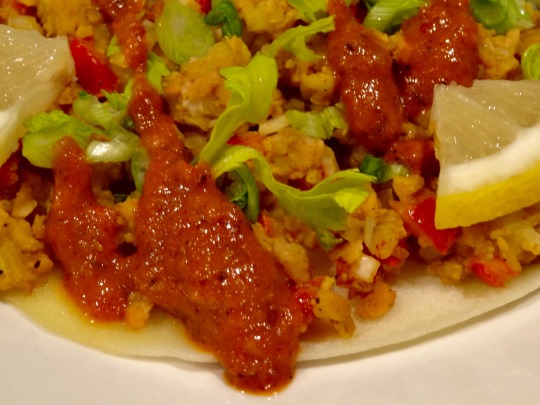
[ID: First image is a thin crèpe topped with ground 'meat,' herbs, and tomato, and garnished with lemon. Second image is a close-up of the same crèpe with a thick red sauce drizzledover it. End ID
𑐔𑐟𑐵𑑄𑐩𑐬𑐶 / चतांमरि / Chatamari (Newari rice crèpe)
𑐔𑐟𑐵𑑄𑐩𑐬𑐶 / चतांमरि (chatā̃mari), sometimes called "Newari pizza," are rice crèpes made plain or with a savory topping. Chatamari are a popular festival food among the indigenous 𑐣𑐾𑐰𑐵𑑅 / नेवा: (Naivāḥ / Newa) people, most of whom live in the 𑐣𑐾𑐥𑐵𑑅 𑐐𑐵𑑅 / नेपाः गाः (Naipāḥ gāḥ / Nepa Valley) in central Nepal. [1] They are regarded as a near-compulsory addition to the table for holidays including 𑐴𑑂𑐩𑐥𑐸𑐖𑐵 / म्ह पूजा (mha pūjā) and 𑐡𑐶𑐐𑐸 𑐥𑐹𑐖𑐵 / दिगु पूजा (digu pūjā), when they are served as snacks and appetizers.
A chatamari consists of a thin, fried crèpe, fluffy on the inside and crispy around the edges, and an optional juicy, well-spiced topping. Common toppings are vegetable (with black-eyed peas, potato, and/or soy chunks); meat (with minced chicken or buffalo and tomato); a cracked egg; or some combination thereof. Ginger, garlic, red onion, cumin, turmeric, and sometimes red chili powder and coriander add bite and aroma. To cook chatamari, a thin layer of batter is spread on a tawa, and the batter is topped; the whole is then covered with a clay conical lid and left to steam.
This recipe is for a 𑐎𑐷𑐩𑐵 / कीमा (kīmā; minced meat) chatamari with potato, but you can try replacing the meat substitute with cooked black-eyed peas, replacing the potato with more meat, or replacing the meat and potato with vegetables of your choice (try green peas, julienned carrots, and green onion)—the basic format of this dish is highly customizable.
The Nepali language is increasingly the language of broadcast, education, and even the home, to the detriment of other languages including the Newa language Nepal Bhasa (𑐣𑐾𑐰𑐵𑑅 𑐨𑐵𑐫𑑂 / नेवा: भाय्, nevāḥ bhāy). Scripts historically used to write Nepal Bhasa and Sanskrit have been almost entirely replaced with Devanagari. 𑐥𑑂𑐬𑐔𑐮𑐶𑐟 / प्रचलित (prachalit; lit. "common") was the script used by literate Newa until it began to decline at the turn of the 20th century; the 1960s governmental policy of सांस्कृतिक एकता (Nepali: sā̃skr̥tik ektā; cultural unity) further marginalized it.
Revival efforts have begun, which claim Prachalit (and the ornamental script Ranjana, also used to write Nepal Bhasa and Sanskrit) as parts of Newa identity, and seek to teach them at fairs and in workshops. A process of "ethnicity-building" and identity formation within Nepal, including pushes to use students' mother tongues as the language of instruction (with Devanagari as a "common" script) and to use minoritized languages in television and radio broadcast, have been ongoing since the 1990s.
[1] Terminology is given in Nepal Bhasa unless otherwise specified, in Prachalit followed by Devanagari script. "𑐔𑐟𑐵𑑄𑐩𑐬𑐶," "𑐡𑐶𑐐𑐸 𑐥𑐹𑐖𑐵," and "𑐎𑐷𑐩𑐵" are my transliterations from Devanagari into Prachalit. Latin transliteration is ISO 15919 standard except: "च" ([t͡ʃə]) is rendered "cha" and not "ca." Where two Latin phrases are given, the first is ISO from Devanagari, and the second is the typical English-language spelling or phrase.
Recipe under the cut!
Patreon | Paypal | Venmo
Ingredients
Makes 4 large.
For the topping:
3/4 cup (74g) textured vegetable protein + 1/2 cup (118mL) broth
Or 1 1/2 cup ground beef substitute of choice
1 russet potato (200g) (optional)
2 roma tomatoes, minced or thinly sliced
1 small red onion, minced or thinly sliced
1 green chili, diced or thinly sliced
1/2-inch chunk (5g) ginger, peeled and grated or pounded
2 cloves garlic, grated or pounded
1 tsp ground coriander
1 tsp ground cumin
1 tsp ground turmeric
1 tsp red chili powder (substitute sweet paprika to reduce spice level)
1 tsp meat masala (optional)
2 Tbsp neutral oil (if not including 'egg')
Cilantro, to top
For the egg (optional):
2 Tbsp yellow mung flour or chickpea flour (besan)
1/4 cup coconut milk
1 tsp kala namak (black salt)
You may also use any other egg substitute. This one is inspired by Vietnamese bánh xèo. The coconut milk provides binding and fat; the final topping will not taste of coconut. You may replace it with any neutral oil.
For the batter:
1 1/2 cup (240g) white rice flour
About 1 1/2 cup (350 mL) cool water
Mustard oil, to fry
The chatamari in the photo is served with achar.
Instructions
For the batter:
1. Measure flour into a bowl. Pour in water slowly while whisking until a smooth, pourable batter (the consistency of crèpe batter) forms. Set aside to rest while making the filling.
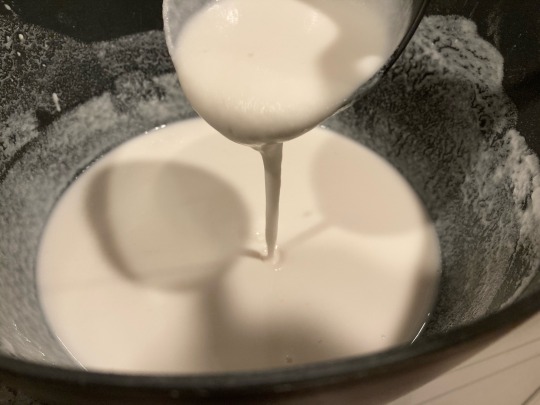
For the filling:
1. Peel and cube potato, then boil until soft. Mash thoroughly with a bean masher or fork.
2. Hydrate TVP in broth or stock (I used water with 1/2 tsp vegetarian beef stock concentrate) for 10 minutes.
3. Mix potato, minced tomatoes and onion, ground 'meat', spices, and 'egg' together in a large mixing bowl until well-combined.
To assemble:
1. Heat a large tawa, comal, or nonstick skillet on medium. Fill a ladle with 100 mL (a bit less than 1/2 cup) of batter, and pour it into the center of the skillet; it should become round on its own. Thin it out a bit with the bottom of the ladle.
2. Cover the top of the batter with the topping, leaving a bit of space on the edge. Optionally, add about 2 tsp of oil around the edges of the chatamari to crisp.
3. Lower the heat to low and cover. Cook for 7 minutes. Remove chatamari onto a plate.
If the rice pancake cracks, your batter is too thin; try resting it, uncovered, for 5-10 minutes, then stirring it and trying again.
4. Raise heat to medium for a minute. Add another ladle of batter, top the chatamari, add oil, lower the heat and cover to cook as before. Repeat until batter or filling runs out.
87 notes
·
View notes
Text
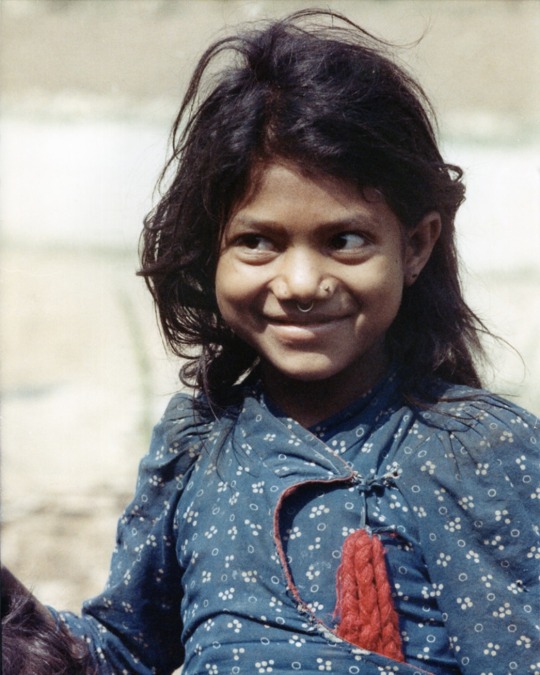


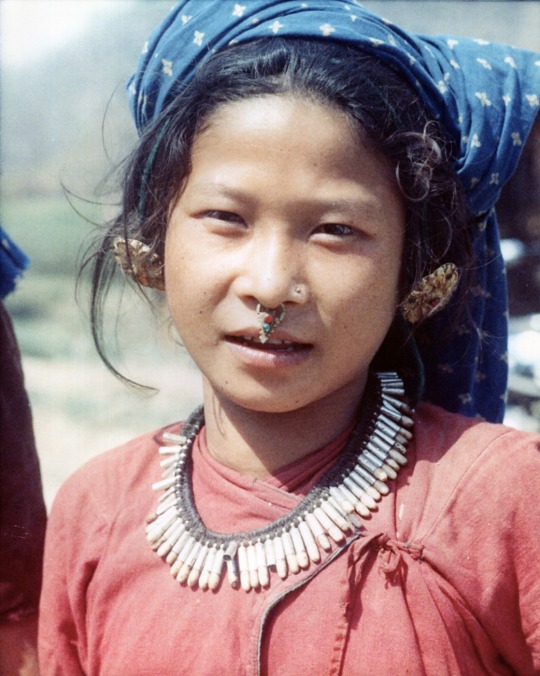


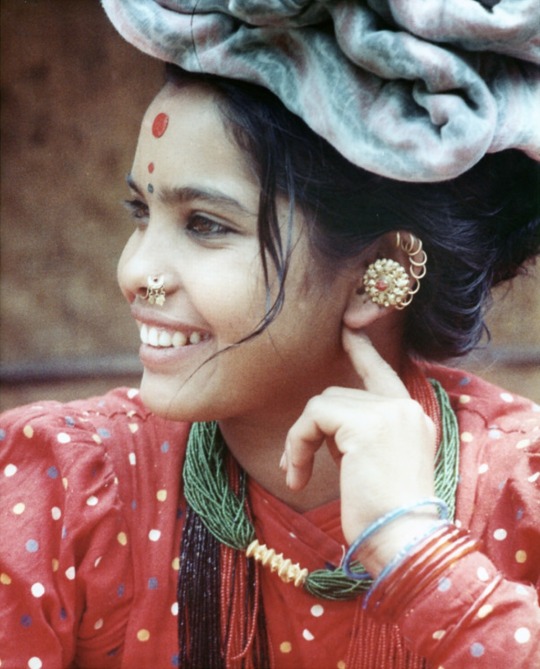





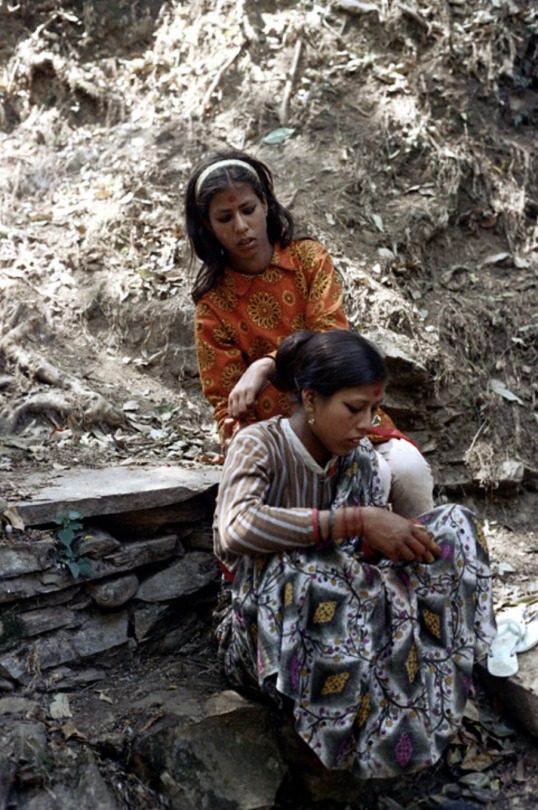
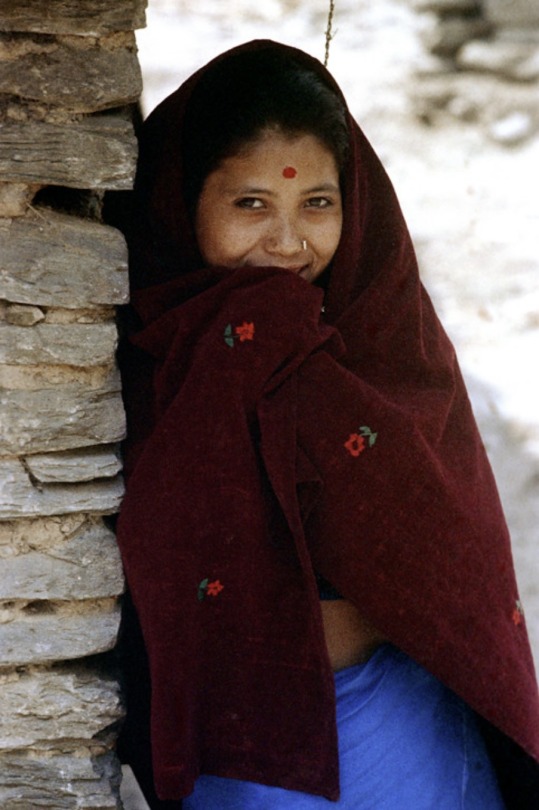




Women and girls of Nepal, 1972.
Photographed by Nick DeWolf.
#1970s#women#*#nepal#nick dewolf#60s 70s 80s 90s#1972#himalayas#south asia#photography#vintage#vintage photos#vintage photography#asia#old photography#women in photography#old photos#nepali#indian#women's empowerment#women's rights#70s#1970s vintage#70s vintage#travel#travel photography
70 notes
·
View notes
Text

Nepali Ai Girl More Gallery
#ai art nepal#ai artwork#ai desi#ai girl gallery#ai image#ai nepal#ai nepali#ai generated#ai model#nepal#ai babe#nepal art#ai girl#ai#nepali#nepali girl#nepali beauty#ai nepala#ai nepal art
19 notes
·
View notes
Text

concept for my version of the sorcerer supreme! Doctor Shreyan Sthapit is your local coffee-loving wizard battling the weird from beyond your perception of reality! please do not dirty the sanctum sanctorum! he will not appreciate it!
I need to draw him more
(but you can see him in action in this fic right here)
#it's literally a crime like i drew him once then never again. baby boy i am so sorry#i will give you glorious art. soon. .#you can tell i absolutely gave up on his silhouette i was like “make him a twig :) easy for reproducibility”#is this secretly fic promotion? yes. i can fucking promote my fic. read it pretty please i worked so hardd#mythic mumbattan au#doctor strange#(but not really....)#spider man india#shreyan sthapit#nepali#<- can i tag it that..?#artoftheagni#desi art#pb im making the boy public!!!!!! :D
43 notes
·
View notes
Text


Nepali Bride by Gourab Ganguli
#gourab ganguli#nepali#nepali bride#south asian#desi tumblr#desiblr#nepal#hands#weddings#jewellery#ph
337 notes
·
View notes
Text

A young Nepali woman performs as Durga in a dance to fight against the devils.
Birch Park, Darjeeling, India
Earl & Nazima Kowall
13 notes
·
View notes
Text
11 notes
·
View notes
Photo

Typography of Devanagari, Bapurao S. Naik, Directorate of Languages, Maharashtra, 1965
70 notes
·
View notes
Text

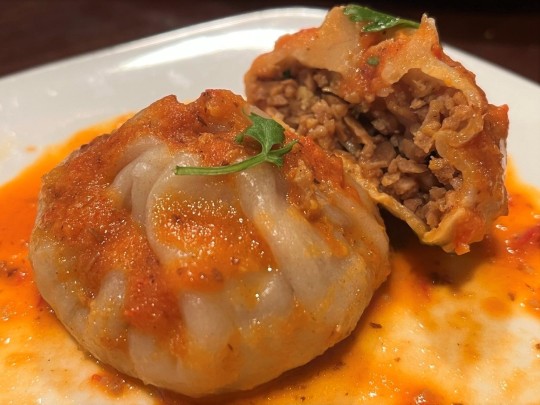
[ID: First photo shows a shallow bowl with six dumplings garnished with cilantro. The dumplings are round, with circular pleats surrounding a small hole at the top of each one. The bowl is filled with a bright red sauce freckled with spices. Second photo is a close-up of one dumpling covered in sauce; another dumpling, cut open to show a ground beef filling, is resting on the first dumpling. End ID.]
Vegan "beef" momos (Nepali dumplings in tomato achar)
Tender wrappers encase flavorful, juicy filling and swim in a spicy, tangy tomato sauce in this Nepali-style steamed dumpling recipe.
Momos originate in Tibet, but are commonly served as a street food or snack in Nepal. Many restaurants in Nepal are known for their unique or distinctive achar recipes--mine is flavored with sesame, ginger, and a spice blend of timir peppercorns, coriander, cumin, turmeric, and chaat masala, but feel free to play around until you get something you like.
Recipe under the cut!
Patreon | Tip jar
Makes 10-12
EQUIPMENT
A bamboo or metal steamer, or a wok / large, deep pan / large pot, with a closely fitting lid
Parchment paper
INGREDIENTS:
For the dough:
1 cup (120g) AP flour
enough water to create a soft dough (about 1/4 cup / 60mL)
For the filling:
2/3 cup (65g) TVP
1/4 cup (60mL) vegetarian 'beef' stock from concentrate (or substitute vegetable stock + 1 Tbsp soy sauce)*
1/2 small yellow onion, grated
1/2 Tbsp grated garlic
1/2 Tbsp grated ginger
2 1/2 tsp momo masala
1/2 Tbsp vegetable oil or vegan ghee
1 tsp salt, or to taste
2 green onions, minced (optional)
*I like TVP because its flavor is so customizable, but if you don't have any you may substitute any other vegetarian ground beef substitute for the TVP and stock.
For the achar:
4 roma tomatoes (300g), chopped
2 tsp sesame seeds
2 tsp cumin seeds
1 tsp coriander seeds, toasted and ground
6 timir or Sichuan peppercorns, toasted and ground
large pinch turmeric
pinch chaat masala (optional)
2 dried bird's eye chilis, crushed, or 2 tsp chili paste
1 Tsbp neutral oil
1 tsp grated ginger
1 tsp grated garlic
1 tsp salt
3/4 cup (180mL) water
squeeze of lime or lemon juice (optional)
For the momo masala:
Nepali momo masala is available commercially from brands such as Century; you can also make it at home by adjusting the following recipe according to your taste or what you have on hand. This spice blend will make about as much masala as needed for this recipe.
1 small bit Ceylon cinnamon (or substitute cassia cinnamon)
3 black peppercorns
1 clove
1 strand mace
3/4 tsp coriander seeds
3/4 tsp cumin seeds
1 small dried chili, or 1/4 tsp Kashmiri chili powder
1/4 tsp ground ginger
1/8 tsp fenugreek seeds
1/8 tsp black mustard seeds
large pinch of grated Indian black cardamom pod (or substitute 1 green cardamom pod)
pinch nutmeg
pinch turmeric
pinch ground cassia cinnamon
INSTRUCTIONS:
For the dough:
1. Measure your flour into a large bowl by weight, or by spooning it gently into a dry measuring cup and levelling it off. Slowly add water (you may need more or less than 1/4 cup / 60mL) until a cohesive, non-sticky dough forms.
2. Knead your dough for 5-10 minutes until it is smooth and elastic. Cover and set aside to rest while you prepare the filling and achar.
For the filling:
1. Add all ingredients to a mixing bowl and mix or knead until well combined. Allow at least 10 minutes for the TVP to hydrate.
For the achar:
1. If using whole spices, toast coriander and Sichuan peppercorns in a small skillet on medium heat for a few minutes until fragrant, and grind them in a mortar and pestle.
2. Heat oil in a large pan on medium. Add sesame seeds and fry 5-7 minutes, agitating often, until they are fragrant and a shade darker.
3. Add cumin seeds and fry until fragrant. Add remaining spices (coriander, peppercorns, and turmeric) and allow to bloom in the oil for 30 seconds.
4. Add ginger and garlic and fry for 30 seconds until fragrant. Add chilis or chili paste and cook for a minute or two.
5. Add tomatoes and salt and cook until tomatoes are slightly softened.
6. Add water and cook, covered, 5-10 minutes until dried chilis (if using) and tomatoes are soft.
7. Blend all ingredients (including cooking water) using a countertop or immersion blender. Add lime and more chili paste as desired.
For the momo masala:
1. Toast whole spices in a dry skillet on medium heat for a few minutes until fragrant and a shade darker. Toast larger whole spices and smaller seeds separately to prevent the seeds from burning.
2. Remove the skillet from heat and toast ground spices for 30 seconds, agitating constantly.
3. Grind all spices together in a spice grinder or mortal and pestle.
To assemble:
1. Divide the dough into balls of about 1” (2.5cm) in diameter (mine weighed about 14g each) and roll each ball out into a 4” (10cm) wide circle. (If you're inexperienced with rolling out circles of dough, you may also divide the dough in two pieces, roll each out into a sheet 1/4" thick, and use a 4" cookie cutter to cut out circles. Allow scraps to rest before rolling them back out.)
2. Hold a wrapper in the palm of your non-dominant hand and add about 2 Tbsp of filling (if you're not experienced with making dumplings, it may be easier to add less). While pressing the filling down with your non-dominant thumb, use your other hand to pinch pleated folds in the dough all the way around the circle of the wrapper. (You may shape your momos to be completely closed at the top, or leave a small hole in the center where your thumb has been--it's up to your preference.)

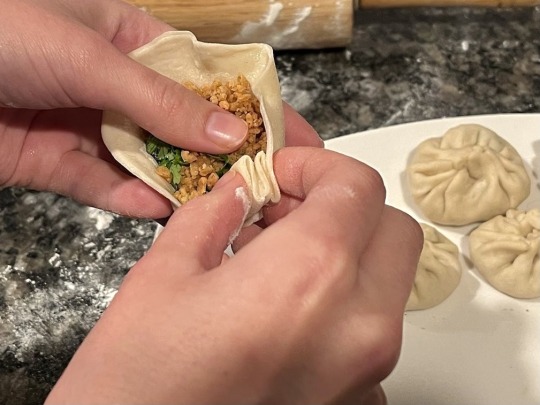

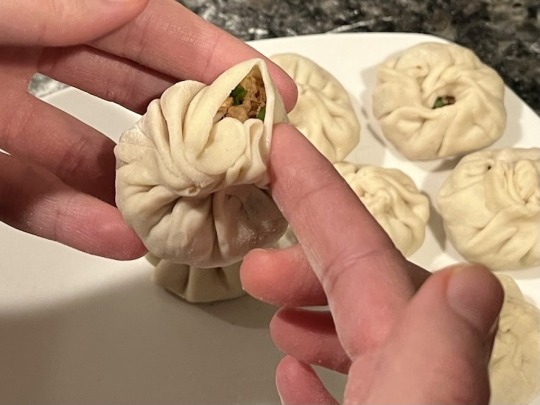
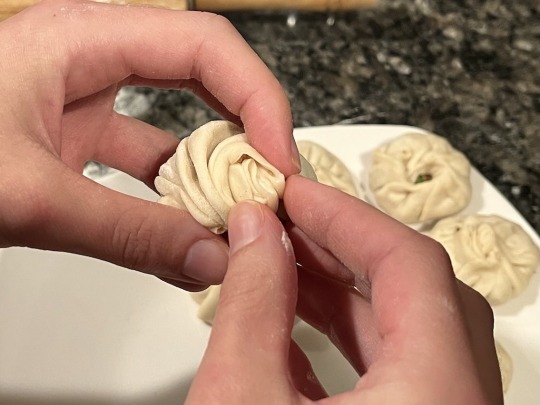
Place completed dumplings on a plate and cover with a kitchen towel to prevent drying out.
3. Steam your dumplings. Place a parchment-paper-lined bamboo steamer in the bottom of a wok or large pot, and fill the wok with enough cool water to cover the bottom rim of the steamer by ½". If you’re using a metal steamer, tie a kitchen towel around its lid to prevent condensation from dipping back down onto the dumplings; line the metal steamer with parchment paper, or oil it, to prevent the dumplings from sticking.
If you don’t have a steamer, place a small bowl in the bottom of a wok or large, deep pan or pot. Place the dumplings on a parchment paper-lined plate and place the plate on top of the bowl–the plate should fit inside your pot. Make sure that you can cover the plate and dumplings with a lid. If your lid is domed, there is no need for a kitchen towel, since the condensation will run down towards the outer rim. If your lid is flat, tie a tea towel around it just as you would with a metal steamer. Fill your cooking vessel with 2 or so centimeters of cool water.
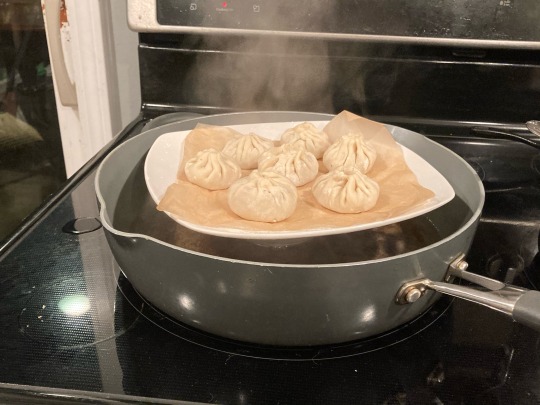
4. Raise the heat to high and allow the water to come to a boil. Once boiling, lower the heat to medium-low and cover your steamer or pot. Steam the dumplings for 6-10 minutes, until the dough is tender and cooked.
Serve warm drizzled with achar, or with achar to the side. You may also mix the achar with a bit more water or stock to thin it out, and serve momos in a bowl filled with achar; this "momo soup" is known as momo jhol achar.
410 notes
·
View notes
Photo

Esan Regmi
Gender: Male
Sexuality: N/A
DOB: Born 1988
Ethnicity: Nepali
Occupation: Activist, entrepreneur
Note: Is Intersex
#Esan Regmi#qpoc#lgbtqia#intersexuality#lgbtqi#male#1988#nepali#asian#poc#activist#entrepreneur#intersex
54 notes
·
View notes
Text

Slingshot . | Make sure you follow > Shot By Canipel & Instagram
26 notes
·
View notes
Text
Nepali Tiktok Celebrity
#ai art nepal#ai artwork#ai desi#ai girl gallery#ai image#ai nepal#ai nepali#ai generated#ai model#nepal#simpalkharel#tiktok#nepali beauty#ai nepala#nepali
3 notes
·
View notes
Text

15 notes
·
View notes